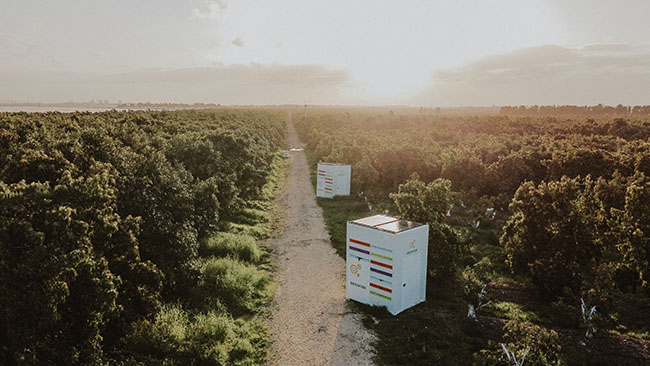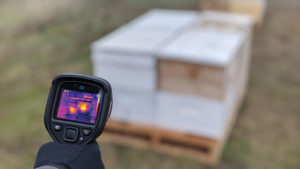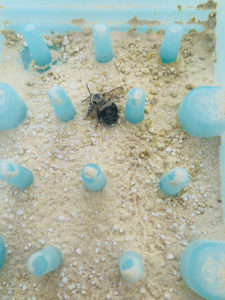
Jan/Feb 2022
The buzz around pollination tech
Throughout the years, seasoned beekeepers – as well as growers – have witnessed a significant increase in colony losses. To help mitigate this loss and provide a more efficient approach to bee care and pollination, companies across the world have developed solutions for beekeepers and growers.
As natural pollinators, honeybees are pivotal to crop production, food security and the economy overall. Almond Board of California states that 33% of our global food production relies on pollinators, and each year 90 U.S. crops are pollinated by commercial honeybees. Ranking at the top is the California almond bloom – the largest pollination event in the world. With colony losses steadily increasing throughout the years, it’s imperative that agriculture does all it can for these pollination partners.
Here’s a peek into the variety of bee-centric technologies available.
Keeping pollinators happy
When it comes to keeping bees in optimal health, the secret is in the continual care and maintenance. A romantic view of beekeeping is that a simple apiary and a little sugar syrup will lead to happy, healthy bees. The trouble is that there’s a little more nuance to the beekeeping process and maintaining a happy, healthy bee takes more than just a beehive and occasional sugar syrup.
The Honey Bee Health Coalition has noticed, “since 2006, there has been a tragic breakdown in honeybee health … this erosion of honeybee health has taken place on an enormous scale, affecting most of North America and parts of Europe.” The breakdown referenced can be traced back to multiple factors like parasites, pathogens, pesticides and poor nutrition. These direct threats to bee health can weaken a colony’s defenses and bee immune systems.
“It’s more than pollination, it’s about keeping the bees alive. If you keep the bees alive, then the whole ecosystem thrives,” said Saar Safra, CEO and co-founder of BeeWise.
The best way to help tackle threats and mitigate potential colony losses is to make sure hives are healthy and productive through consistent monitoring, maintenance and accurate data. Most of the tech listed here focuses these very things.

A.I. and robots
A great way to monitor and ensure bee health is by identifying problematic factors quickly and taking care of them equally as fast. With artificial intelligence and careful data monitoring, beekeepers and growers can do exactly that. Designed specifically to treat bee health effectively, technology like robotic BeeHomes can allow beekeepers to easily monitor the health and environment of all their bees simultaneously, as well as treat them in real time.
• The company: BeeWise focuses on the well-being and longevity of the bee through an autonomous beehive, the BeeHome. Headquartered in Israel, Beewise is currently available in North America exclusively, and proudly caters to commercial beekeepers managing 1,000+ beehives.
• The tech: BeeHome is a large, robotic hive that allows beekeepers and growers to inspect and treat colonies from a distance. Each BeeHome is equipped with precision robotics, computer vision and artificial intelligence. BeeHomes can identify and treat illnesses and pests, address climate-related problems, prevent bee swarms, harvest honey and more. It can support up to 24 colonies in a single BeeHome.
• The benefit: BeeWise offers the first autonomous beehive. The information collected by each BeeHome allows beekeepers to make optimal, data-driven hive management decisions easily. The robotic arm can accomplish a multitude of tasks, and a beekeeper can also enter the unit if necessary.

Hive grading
Another way to ensure a successful pollination season is through hive grading, or measuring the strength and pollination value of your honeybee colonies. Some bee brokers, such as Exchange Bees, have begun offering hive grading via infrared as an additional service. The difficulty is knowing where to start.
Who takes the measurements? How are they interpreted? What is the best way to help make pollination decisions for the future?
The Bee Corp developed a unique set of metrics and Verifli technology designed to help farmers and beekeepers measure the effectiveness of their bee pollination. These metrics can help illustrate pollination revenue per hive and optimize future management costs and quality.
“By helping beekeepers see the value of their bees and communicate it, they can make smarter, more data-driven decisions regarding their upcoming pollination,” said Wyatt Wells, COO and co-founder of The Bee Corp.
• The company: The Bee Corp allows users to collect objective third-party hive strength assessments through the Verifli platform
• The tech: Verifli is a non-invasive, infrared technology that measures a hive’s thermal signature to help determine colony size and pollination value. Verifli is used by growers, beekeepers and researchers across five countries and three continents.
• The benefit: Transparency to the pollination market. Growers can know the strength of the hives before being placed in the field. This helps growers determine the value of the hives they rent, and ensures beekeepers are compensated for the value they provide.
Monitoring inside the hive
Grading hives via infrared is one option for getting an idea of what’s going on inside, but sensors in and on the hive also provide valuable data. From BeeHero’s Silicon Valley headquarters to New Zealand’s HiveMind, sensors placed at the hive are providing results on a variety of metrics, such as hive temperature, mite infestation and more.
• The companies: BeeHero, HiveMind, Ubees and others, with each offering slightly different versions of sensors, data collected and dashboards/apps.
• The tech: Sensors are placed in and/or on the hive for monitoring a range of factors, including bee health, microclimate, hive temperatures and locations and other information.
• The benefit: Growers and beekeepers can collect extensive data about what is happening in the hives, what is affecting them, and can make real-time decisions while monitoring remotely.
Tracking outside the hive
Data collection of bee health and pollination effectiveness does not stop at the hive. During the small window that growers have for pollination, bee monitoring is vital.
“This data – knowing how the bees behave after they leave their hives, where in the orchards they gather, etc. – helps farmers and growers make smart decisions to increase their yields,” said David Lyall, CEO and founder of Bee Innovative, a company using a type of radar that tracks bees in the field.
• The company: Bee Innovative is an Australian agtech company focused on the identification, tracking and reporting of bee pollination.
• The tech: BeeDar (appropriately named for “bee” and “radar”) technology tracks bee movement and pollination activity after leaving the hive, and provides farmers real- time data to help maximize pollination, reduce waste, and improve yield size and quality. Currently, BeeDar is being utilized by growers in Australia and is looking forward to being used worldwide – including California almond orchards – in the near future.
• The benefit: While other tech is monitoring the hives themselves, Bee Innovative’s BeeDar can provide a bee count outside the hive, and provides current and accurate data regarding bee movement.

Vectoring for disease control
A novel use of the pollination period is bee vectoring – the process of precision delivery of biofungicides by commercial bees to the blooms. As bees exit their hive to forage for pollen, they travel through a VectorHive dispenser, pick up minute amounts of biofungicide, and bring it to the blossoms. This process helps reduce spray and wait cycles during bloom time, increase farmworker productivity due to zero restricted-entry intervals, and introduces a new physical mode of targeted crop protection and increased production.
• The company: BVT provides a novel management system for growers that delivers highly targeted and effective pest and disease control. BVT has an established base of berry grower customers in the US and just completed its first almond trials in California this past growing season.
• The tech: The VectorHive system utilizes the natural pollination process of
bees to address fungal diseases and pest issues. Bees carry tiny amounts of biofungicide and deliver it to blossoms.
• The benefit: This process can potentially empower growers to reduce their use of traditional fungicides, reduce inputs and costs, and help protect beneficials and biodiversity.
Using a different bee
The honeybee is by far the famed pollinator, but there are other bees available to growers for pollination. Some beekeepers, such as Watts Solitary Bees, offer orchard mason bees, or California blue orchard bees, which can pollinate in cool or rainy weather, and can supplement or replace honeybee pollinators.
• The company: Watts Solitary Bees is based in Washington, and California consultants, such as Foothill Bee Ranch, can help growers maintain their hives and populations.
• The tech: A different species of bee. These California native bees prefer nesting in holes in wood, and there is not one queen but multiple females that prefer to make their nests near each other, which provides enough bees for commercial pollination.
• The benefit: Blue orchard bees are more effective pollinators. Four hundred orchard bees pollinate the same as 1,500+ honeybees, and can pollinate in cold, windy or rainy conditions. Growers can also buy the pre-drilled hive kits and own the bees, as well as harvest cocoons for subsequent generations.
Controlled pollination
Bees may be monitored, but how well they pollinate and where is still left up to chance. Controlled pollination helps to fill that gap. Pollen is harvested from healthy trees and undergoes various proprietary processes for purification, blending and to add additional nutrients. Companies such as Antles Pollen Supplies and Firman Pollen Co. offer hive entrance and tree dusting applications.
• The companies: Antles has been around since 1929 and offers various tree nut pollens in addition to almond, such as pistachio, pecan and hazelnut. Firman also has a long history, dating back to 1933, and offers a new electrostatic pollination application option.
• The tech: Pre-harvested, purified and blended pollen for various application methods, such as directly to a hive entrance (so bees pick it up and carry it), machine-blown onto trees, or mixed with water and applied via electrostatic sprayer.
• The benefit: Reduces the effects of poor bee activity and delivers consistent and evenly applied, high-grade pollen to ensure pollination.







